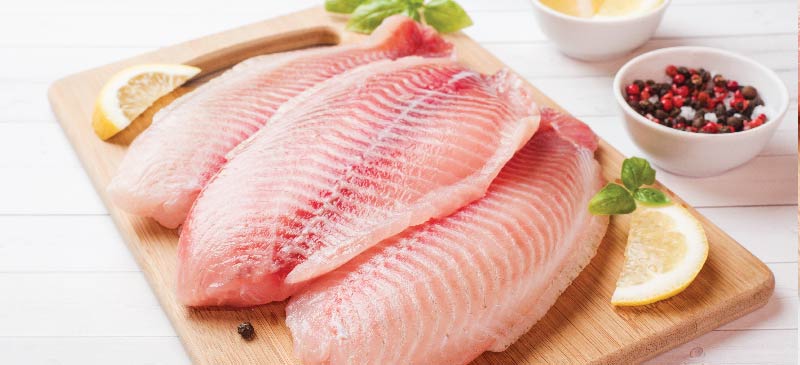
Fish can either be helpful or harmful to your health, depending on where it’s sourced. Tilapia, in particular, has become extremely popular in aquaculture and aquaponics across Asia, Mexico, Central America and the U.S. because it’s highly affordable, grows quickly and adapts well to new environments.
But although fish is often praised for its powerful health benefits, certain types of tilapia have been associated with some serious side effects, including concerns about bacterial contamination, antibiotic resistance and unsustainable farming practices.
So is tilapia a real fish? And is tilapia healthy? Here’s what you need to know about this popular type of seafood.
Related: 17 Fish You Should Never Eat, Plus Safer Seafood Options
What Is Tilapia?
Tilapia is the common name for nearly 100 species of white fish in the cichlid family. Mainly a freshwater fish, tilapia live in shallow streams, ponds, rivers and lakes.
Like other types of fish such as swai fish, tilapia adapt well to being farmed and are very inexpensive. They are farmed around the globe, but are especially common in many parts of Asia and the U.S. The largest tilapia producers in the world are China, followed by Egypt. In the U.S., it is the fourth most consumed fish.
Tilapia is favored for its mild taste and firm, flaky texture, making it a good option for those who don’t typically like seafood. It’s also very versatile and can be baked, broiled, grilled, fried or sautéed as a simple weeknight staple.
Types
Today, the three most commonly fished and eaten species of tilapia are Nile, Blue and Mozambique.
Oreochromis niloticus, or Nile tilapia, is the oldest variety and is native to northern Africa and Israel. Nile is one of the most adaptable fish, as it can be raised in various ways and is considered one of the most sustainable farmed fish.
Meanwhile, Blue tilapia is found in Florida’s lakes, rivers and streams. Unlike other varieties, it can live both in saltwater and freshwater. However, because it doesn’t grow as quickly as Nile varieties, it’s not as commonly farmed.
Finally, Mozambique tilapia was introduced into the U.S. for sport fishing and as a means of aquatic plant control. It is now found in tropical and subtropical habitats worldwide and is popular among fish farmers because it is easy to grow and readily adaptable.
Nutrition Facts
Tilapia is low in calories and fat but loaded with protein. It’s also a good source of several vitamins and minerals, including selenium, vitamin B12, niacin and phosphorus.
A 3.5-ounce serving of cooked tilapia contains the following nutrients:
- 128 calories
- 0 grams carbohydrate
- 26 grams protein
- 2.5 grams fat
- 54.4 micrograms selenium (78 percent DV)
- 1.9 micrograms vitamin B12 (31 percent DV)
- 4.7 milligrams niacin (24 percent DV)
- 204 milligrams phosphorus (20 percent DV)
- 380 milligrams potassium (11 percent DV)
- 34 milligrams magnesium (8 percent DV)
- 0.7 milligrams panothenic acid (7 percent DV)
- 0.1 milligrams vitamin B6 (6 percent DV)
- 0.1 milligrams thiamine (6 percent DV)
Each serving also contains a small amount of vitamin E, riboflavin, iron, zinc and copper.
READ RELATED: What Is EGCG? Benefits, Dosage, Safety & Top Foods/Drinks
Safe to Eat?
There are several serious concerns associated with tilapia, regarding both its nutritional profile and the way that it’s raised and produced.
Tilapia fish farming practices in China, in particular, have drawn a good amount of controversy in recent years. According to one report published by the USDA, it is common for fish farmed in China to be fed feces from livestock in an effort to cut costs. However, this can also increase the risk of contamination and foodborne illnesses such as Salmonella, which can be serious if left untreated.
There is also concern regarding the risk of contamination and the use of harmful chemicals in many fish farmed in China. Some of the chemicals used in tilapia production are also illegal, which has caused multiple tilapia imports from China to be rejected within the past few years. A report conducted by Seafood Watch also noted that antibiotic resistance in certain strains of bacteria has been linked to tilapia farming regions in China as well.
Selecting wild-caught tilapia or farm-raised varieties sourced from countries like the U.S., Peru or Ecuador can be a good alternative to help minimize exposure to harmful antibiotics, chemicals and pesticides while also supporting more sustainable farming practices.
In terms of nutrition, tilapia is also low in omega-3 fatty acids yet high in omega-6 fats compared to other types of fish. Although omega-6 fatty acids are an important component of a healthy diet, the typical western diet contains a higher ratio of omega-6 fatty acids to omega-3s.
Not only can this poor omega imbalance drive up inflammation in the body, but it may also contribute to the development of chronic conditions like heart disease, Alzheimer’s disease and rheumatoid arthritis.
Potential Benefits
Despite concerns about this controversial ingredient, there are a few potential tilapia fish benefits to consider as well.
For starters, it’s a good source of several nutrients, including selenium, vitamin B12, niacin and phosphorus. The tilapia nutrition profile also boasts a whopping 26 grams of protein per serving, putting it right on par with other high-protein foods like poultry and meat.
Protein is important for many aspects of health and plays a key role in tissue repair, muscle growth, energy levels and immune function. Increasing your intake of this essential macronutrient can also help keep your waistline in check. Studies show that protein can reduce levels of ghrelin, which is the hormone that stimulates feelings of hunger, and may even decrease appetite and calorie consumption to support weight loss.
Furthermore, because tilapia fish is a lean protein and contains less than 3 grams of fat per serving, it is also lower in calories than other types fish. Salmon, for example, contains 206 calories per serving whereas sardines provide 208 calories. For this reason, it can easily be incorporated into a low-calorie diet for those looking to lose weight.
Compared to other types of seafood, tilapia is also widely available and relatively inexpensive. It also has a very mild flavor, making it a good option to start including more seafood in the diet for those who might not regularly eat fish.
Healthier Alternatives
If you do decide to include tilapia in your diet, it’s best to steer clear of any fish farmed in China. While wild-caught varieties are always best, they can be relatively hard to find and may be more expensive.
If opting for farmed tilapia, Seafood Watch recommends looking for fish raised in Peru or Ecuador instead. Fish farmed in the U.S., Taiwan, Colombia, Mexico, Honduras and Indonesia are also considered good alternatives as well.
Here are a few other healthy fish that you can include in your diet instead:
Final Thoughts
- Tilapia is the common name for about 100 different species within the cichlid family.
- There are several different types, including Mozambique, Blue and Nile, which is also known by the tilapia scientific name, Oreochromis niloticus.
- Is tilapia fish good for you? There are some serious concerns with tilapia farmed in China, including a higher risk of contamination with harmful bacteria, chemicals, pesticides and antibiotics.
- Tilapia also contains a higher amount of omega-6 fatty acids than other fish. Consuming a high ratio of omega-6 to omega-3 fatty acids could contribute to inflammation and chronic disease.
- However, despite the many tilapia warnings, drawbacks and side effects, tilapia is cheap, low in calories and high in protein. It also has a mild flavor and is more widely available and affordable than other types of fish.
- When purchasing seafood, it’s important to pay close attention to the tilapia origin. Opt for wild-caught varieties whenever possible or choose farm-raised fish from either Ecuador or Peru.
Source: Dr. Axe | Nutrition






